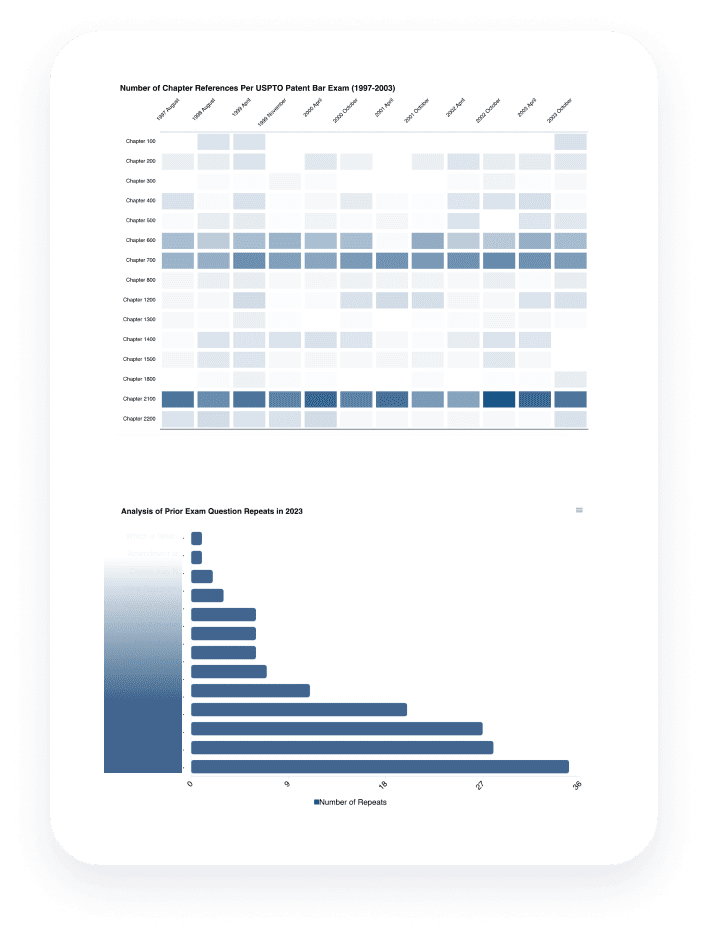USPTO Patent Bar Exam
Discover the Essentials of the Patent Bar Exam
Efficient, Stress-Free Exam Prep: Our expertise in the Patent Bar Exam ensures a smoother enrollment, study, and passing process.
Multiple choice questions
Hours to finish
Minutes for lunch
Score needed to pass
Three hours segments
Answers per question
Understanding the Patent Bar Exam Structure
To practice patent law before the USPTO, passing the Patent Bar Exam is essential. This requirement applies to becoming a registered Patent Agent (without a JD) or a Patent Attorney (with a JD). Our guide breaks down the exam’s structure for clear understanding.
Understanding Costs for the Patent Bar Exam
Including USPTO admission and testing fees, expect to spend around $500 to apply and sit for the exam, plus a $200 registration fee upon passing. While some fees are refundable and the registration fee is post-passing, it’s crucial to incorporate these expenses into your exam preparation budget.
USPTO registration fee
Prometric Test Fee
Commercial test fee
Post Passing registration fee
The Patent Bar Exam: Explained
The United States Patent and Trademark Office (USPTO) Patent Bar Exam, officially known as the Registration Examination, is a critical step for individuals aspiring to become patent agents or patent attorneys in the United States. This exam is designed to assess the candidate’s knowledge of patent law and USPTO procedures, which are essential for practicing in the field of patent prosecution—helping inventors secure patents for their inventions.
Who Can Take the Patent Bar Exam?
Eligibility for the Patent Bar Exam is quite specific, focusing primarily on a candidate’s educational background. The exam is open to those who hold a degree in science or engineering, which qualifies them to understand the technical aspects of patents. Degrees commonly accepted include biology, chemistry, engineering (all disciplines), computer science, and physics, among others. Those without a degree in these fields may still qualify through a combination of education and practical engineering or scientific experience.
The USPTO provides three main categories under which applicants can qualify:
- Category A: Holding a bachelor’s degree in one of the technical fields listed by the USPTO.
- Category B: Possessing a combination of scientific or technical college courses that meet specific requirements.
- Category C: Having practical engineering or scientific experience, verified through passing the Fundamentals of Engineering test or equivalent evidence.
What is the Format of the Patent Bar Exam?
The Patent Bar Exam is a computer-based test administered year-round at various testing centers across the United States. The exam consists of 100 multiple-choice questions, split into two 50-question sessions. Candidates are given three hours to complete each session, with a one-hour break between sessions.
The questions are designed to evaluate a candidate’s knowledge of the Manual of Patent Examining Procedure (MPEP), a comprehensive text that outlines the laws and regulations that govern patent law in the U.S. The exam covers various aspects of patent law, including patentability, inventorship, claim interpretation, and the duties of both patent examiners and patent practitioners.
Preparing for the Patent Bar Exam
Preparation is key to success on the Patent Bar Exam. Many candidates enroll in Patent Bar prep courses, which provide comprehensive study materials, including summaries of the MPEP, practice exams, and test-taking strategies. These courses are tailored to cover the most relevant and frequently tested areas of the MPEP and patent law.
Self-study is another viable approach, though it requires a disciplined study schedule and access to up-to-date materials. The USPTO offers an online practice exam that helps candidates familiarize themselves with the format and types of questions asked on the real exam.
The Importance of the Patent Bar Exam for Patent Agents and Patent Attorneys
Passing the Patent Bar Exam qualifies an individual to register as a patent agent with the USPTO. Patent agents can prepare, file, and prosecute patent applications on behalf of inventors. For those interested in becoming patent attorneys, passing the exam is a prerequisite before practicing patent law, although they must also hold a law degree and pass their state’s bar exam.
Patent agents and patent attorneys play critical roles in the innovation ecosystem. They assist inventors in securing intellectual property rights, which can protect inventions and potentially lead to significant commercial and competitive advantages.
Conclusion
The USPTO Patent Bar Exam is a rigorous and comprehensive examination that ensures candidates are well-versed in U.S. patent law and are capable of competently representing inventors in the patent application process. Whether you are an aspiring patent agent or patent attorney, thorough preparation for this exam is crucial. Utilizing resources such as Patent Bar prep courses and adhering to a consistent study plan can greatly enhance your chances of passing the exam.
For those with a background in science or engineering and an interest in the legal aspects of technology and innovation, becoming a patent practitioner offers a rewarding career path. With dedication and proper preparation, passing the Patent Bar Exam is an achievable goal, paving the way for a successful career in patent law.
get started
Pass the patent bar and become a leading patent practitioner today!
Continuous updates to content
We continue to refine and update our study materials and questions to ensure you are studying exactly what is needed to pass the patent bar exam.
Your personalized Patent Bar Review
Your platform enables you to study at your own pace with real-time data feedback, community support, and more.
Save up to 50% time and money
Expertise and Data Insights
Our patent bar review team has served more than 6000+ individuals pass the patent bar exam. We built Wysebridge.com to help you accelerate your patent and IP law career.

